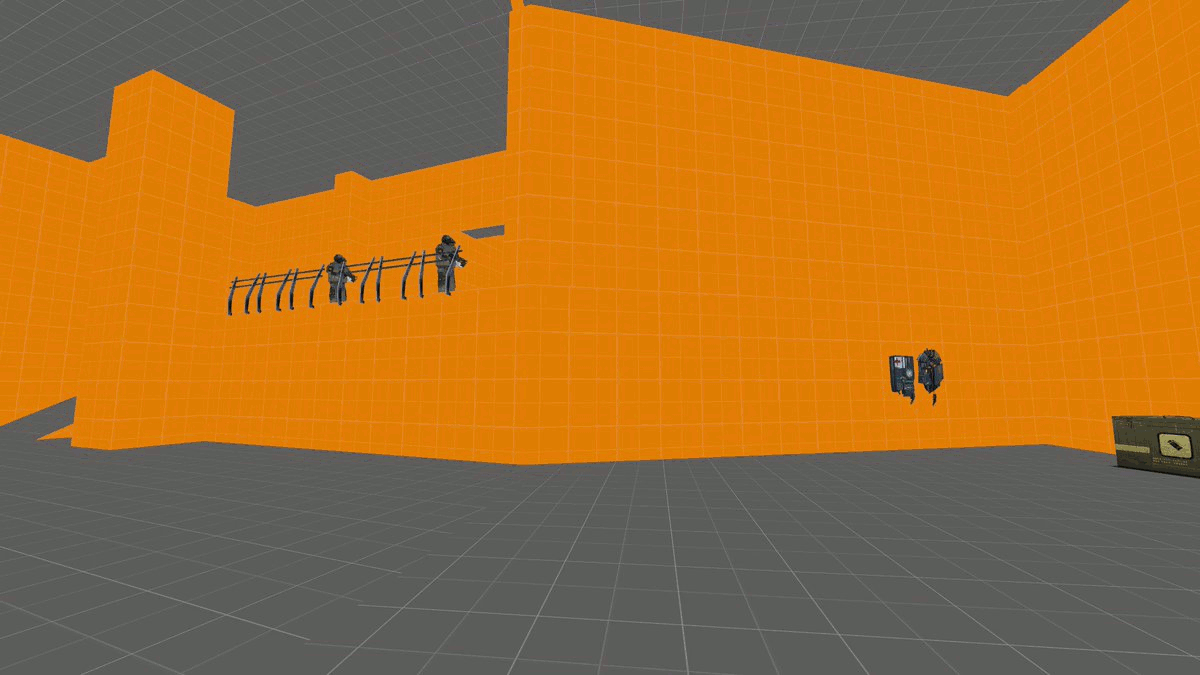Somatic - Half-Life 2 chapter (April - September 2019, Source)
Designer, project leader
Singleplayer mod for Half-Life 2: Episode Two. I was the project leader, managing a team of artists and a composer to create environment art and new music. I designed and scripted the level, and gave direction on visuals while also doing much of the texturing and lighting.
Somatic is available for download at ModDB.

With each game project I work on, I make decisions about high level goals--ways I can push myself. Doom is a 2D game with simple mechanics, Quake is in 3D, and Half-Life 2 felt like a good next choice. It's a further increase in complexity of tools and design, with a larger emphasis on pacing and atmosphere. A good project to show what I've learned.
Half-Life: Somatic is also my thesis for George Brown's Postgraduate Digital Design program. I had a deadline of three months, with the option of bringing on hands to help with art, code and sound, and a mentor to give feedback. With extra people onboard, I pitched a Half-Life 2 mod with a new puzzle mechanic: a clone that repeats the player's actions a la The Swapper. This was to sit alongside Half-Life's traditional gameplay, and the project would feature procedural music that would change based on gameplay. Well, schedules change, and programmers were not available. So we dropped the clones and Somatic continued forward as a tribute to Half-Life.
When starting on a level I gather ideas by reverse engineering design rules from the source material. Then I gather every setpiece, combat encounter and architectural sketch I can think of. The ones that synergize go on an intensity graph, and I start thinking of how areas will fit spatially. Then I move into paper layouts and refine them until I'm happy.

For Somatic I wanted a unique setting, after seeing the environments of so many Half-Life 2 mods blend together. The assets for the monastery in Half-Life: Lost Coast are sorely underused, so I decided to have the player travel under a church to a Combine outpost, an idea borrowed from Minerva: Metastasis.
Every week I would show the project to my mentor, Brad Furminger, a Silicon Knights alumnus. His enthusiasm for the project was infectious, and by repeatedly going through the level with different playstyles he showed me ways of approaching the level that I hadn't thought of. It helped greatly in tightening combat setups and squashing bugs.
With Somatic I continued my design style of tight, interconnected environments, while trying to fit large setpiece rooms to add a sense of scale and vastness to Combine architecture. This was the biggest challenge, because Half-Life's architecture is less abstract than previous games I worked on. A church has to behave and operate like a church, with scale to match. I spent lots of time rearranging spaces to get spaces to line up, and near the end I was slicing walls to stop areas from jutting into each other.

For visuals, the artists--Calder and Liz--would work off my lightly textured and decorated rooms. I would give them direction and they would bring the areas to life. At the end I would make minor changes and do the lighting. Hammer isn't the most robust editor to work with, so progress started slow but eventually worked quite fast. Liz worked on the church interiors and basement, Calder did some of the later Combine rooms and I handled the rest. I’m no level artist but I enjoyed implementing the visuals more than I expected.
For audio, Ethan and I had wanted to work again after Out of Time. His own thesis was to try implementing procedural audio, where music would generate on the fly to match gameplay states. After much investigation and conversation, it didn't look to be feasible on the Episode 2 branch of the Source Engine. Instead Ethan produced stims, individual sound samples that we scripted to play in different areas in different combinations and volumes. The result isn't dynamic but allows for something livelier than your traditional Half-Life experience.

I took an extra month after school to polish the level on my own before I felt it was ready. Public reception was positive—I was not expecting a YouTube playthrough to get 10k views! There were some complaints over the spartan outdoor area, which I adjusted in an update by tightening the fence perimeter and adding debris. There was also mention of not enough enemies. Most of my playtesters don’t play shooters on PC, and those that did are already fans of Half-Life, so I wrote it off when they breezed through fights. Version 1.1 moved the graveyard closer in to further break up the grassy plane. I also added extra enemies and changed up some node pathing, which made enemies in the graveyard fight a lot more aggressive, finally using cover.
The result is the largest-scale project I’ve made, with the largest responsibility yet of leading a small team. I know I’ve come out the other side a stronger designer, and we made something that hits a lot of the beats of Half-Life. I’m especially proud of the pacing and the Metroid-style escape sequence.

Credits:
Design - Ian Colquhoun
Art - Calder Brown, Elizabeth Ip
Sound - Synthmilk
Thanks to - Brad Furminger, all playtesters